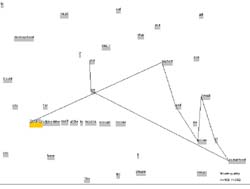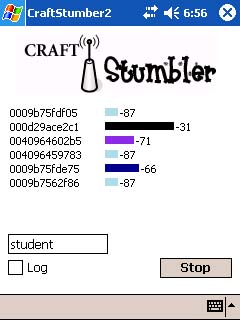Measuring Text and Fonts
Posted: May 16th, 2004 | No Comments »I could not remember how to measure the length of a text according to its fonts (a classic in GUI programming). So here we go:
Read the rest of this entry »
I could not remember how to measure the length of a text according to its fonts (a classic in GUI programming). So here we go:
Read the rest of this entry »
I reached the 2000 spams in my filter yesterday (gathered form March 10). About time to make something out of it. After mentionning it several time with Nico and Cyril, I finally quickly implemented a basic idea of SpamPoetry which to play with the words and sentences received on a daily basis thru spam mail. The hypothesis on this project is that informative art will form Latent Semantic Analysis and some good visualizations.
Spam Poetry: http://www.girardin.org/fabien/spampoetry/

The trend is really at companies going to where creative people are and gather.
As read in the new Google Blog:
“When we announced the opening of our engineering office in Zurich, a lot of Europeans seemed pleased about the possibility of working for Google without a commute to California. Zurich draws Italians, French, Swiss, Germans, and other Europeans, and is easier to reach from most parts of the continent than the Amphitheatre Parkway exit off highway 101.”
“Google benefits from a diversity of languages.”
Are “bloomberg interfaces” the way of the future? While watching a short movie on HP’s vision of the future at the HP Invent Center in Geneva, I was surprised by their use of heavy interfaces where unrelated, fast-moving information are displayed on one screen.

Example of what a bloomberg interface is
With the emmergence of cameras embedded cellphones, augmented reality is democratizing. Michael Rohs from the Distributed Systems Group at the ETHZ presented us last Thursday his Entry Points into a Smart Campus Environment which is part of the ETH World initiative at ETH Zurich. In Rohs’ project, ETHOC bar codes are entry points that give the opportunity to interact with the virtual campus (ETH World) from the physical campus. Cellphones equipped with a camera and a visual code recognition software can decrypte the code. The ETHOC portal is used for the creation of virtual counterparts for printed material.
The same day, Dan Gillmor wrote on Real-World Hyperlinks Via Mobile Phone and mentionned Semacode another applicatio which creates a gate between the real world and virtual world of the Internet.
A paper Marvin McNett and Geoffrey M. Voelker on the use of PDA at the University of California San Diego “Access and Mobility of Wireless PDA Users“. A few quotes:
Read the rest of this entry »
CraftStumbler2 my Pocket PC utility for 802.11b based wireless network auditing is running. It is based on CraftDeamon a C++ DLL which calls NDIS functions on the IEEE 802.11 NIC and returns the detected BSSIDs and their attributes stored in the IEEE 802.11 NIC’s database. CraftDeamon’s methods are exported to be invoked by CraftStumbler (C# client) which displays the access points’ MAC addresses and signal strength and if selected redirects the data to a remote server (Java) which logs them on a centralized database.

Writing Mobile Games Using the Microsoft .NET Compact Framework describes how I should develop the CatchBob! (part of the Location Matters research project) user interface. Full Screen Game Form, Overriding OnPaint and OnPaintBackground, and Off Screen Bitmap Technique For Painting techniques will be usefull.
Among many considerations and differences in developping for .NET Framework or .NET Compact Framework, creating controls for the Compact world has some tricks to be aware of. Some articles try to explain it:
- Creating Custom Controls for the .NET Compact Framework
- How to Create a Microsoft .NET Compact Framework-based Image Button
- Color Button for the .NET Compact Framework
Another article which gives overview on the different ways of using existing code from within C#: Using Win32 and Other Libraries